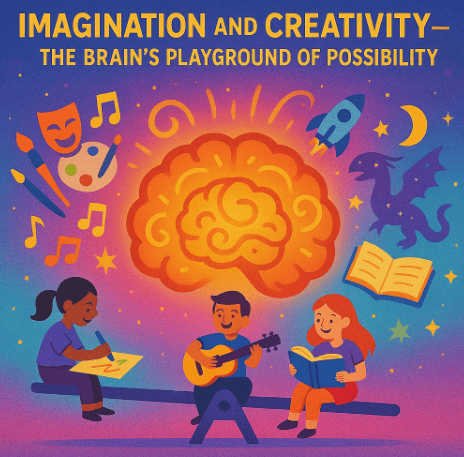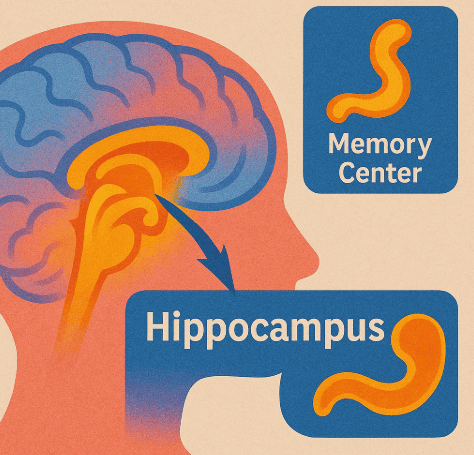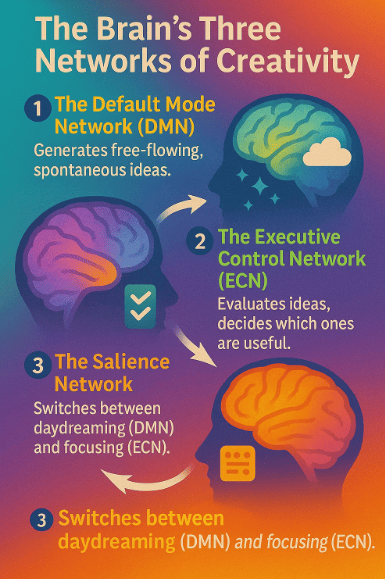
So far in this topic, we’ve journeyed from sparks to thoughts, watched the brain use its problem-solving toolbox, and explored the secret decision-making engine that balances risks and rewards.
We then examined the great tug-of-war between logic and emotion, and learned that the best decisions come when they cooperate rather than compete.
Now we arrive at one of the most magical abilities of the human brain: imagination and creativity.
This is where the brain doesn’t just solve problems – it invents new worlds, paints new pictures, composes new music, and dreams up solutions that have never existed before.
But how does it do this?
Let’s step inside the brain’s playground.
What Is Imagination? 🌌
Imagination is the brain’s ability to form images, ideas, and possibilities that are not right in front of you. If I ask you to picture a purple elephant dancing on the moon, you can instantly imagine it – even though you have never seen such a thing.
That ability to go beyond reality is imagination.
Scientifically, imagination is not handled by one single “imagination spot” in the brain.
Instead, it is the product of many brain regions working together in a network.
One of the most important of these is called the Default Mode Network (DMN). The DMN switches on when your brain is not focused on a specific task, like when you are daydreaming or letting your thoughts wander.
This network pulls together memories, emotions, and knowledge, mixing them like ingredients in a soup to create new mental images.
Another key player is the prefrontal cortex, the same part we studied in logic and decision-making.
In imagination, it helps shape and refine the wild ideas that come from daydreaming, so that they can be useful rather than random. It is like the teacher in the playground – letting the kids play freely, but guiding them enough so they do not run into chaos.
Memory as the Seed of Creativity 🌱
Every act of imagination is rooted in memory. The brain cannot create something from absolute nothing – it always starts with raw material from past experiences.
For example, when you picture a dragon, your brain may combine the memory of a lizard, the wings of a bird, and the fiery glow of a campfire.
By recombining old memories in new ways, your brain produces something entirely novel.
The hippocampus, which stores and retrieves memories, works like a giant library, lending old books to the imagination process.

This explains why people who have rich life experiences—travelers, readers, learners – often show greater creativity.
The more “books” you have in your memory library, the more ingredients your brain can mix to cook up fresh ideas.
The Science of Creativity 🎨🧠
Creativity goes a step further than imagination. While imagination produces images and possibilities, creativity involves turning those possibilities into something valuable or expressive.
A child may imagine a magical forest, but creativity transforms that vision into a painting, a story, or a video game.
Neuroscientists have discovered that creativity does not come from one brain region but from the interaction between three major networks:

-
The Default Mode Network (DMN): Generates free-flowing, spontaneous ideas.
-
The Executive Control Network (ECN): Centered in the prefrontal cortex, it evaluates those ideas, deciding which ones are useful.
-
The Salience Network: Acts as a switchboard, deciding when to switch between daydreaming (DMN) and focusing (ECN).
Together, these networks form a loop.
The DMN throws out wild suggestions, the ECN filters and shapes them, and the Salience Network moves the brain back and forth between imagination and control.
This dance allows humans to create poetry, design buildings, compose music, or even invent rockets.
Daydreaming: The Brain’s Sandbox 🏖️
People sometimes think daydreaming is lazy or unproductive. In reality, it is one of the brain’s most powerful tools for imagination.
When you let your mind wander, the DMN activates strongly, exploring connections that would never appear if you were focusing too narrowly.
This is why so many great ideas appear when people are showering, walking, or drifting to sleep.
The brain, freed from strict focus, begins to shuffle its deck of memories and ideas, sometimes finding a winning combination.
Famous scientists like Einstein and artists like Mozart credited daydreaming and playful wandering of the mind as key to their creativity.
Emotion and Imagination ❤️🔥
Emotions are not separate from imagination – they fuel it. Think about a sad song: the notes themselves are simple, but it is the emotional tone that gives them power.
When you imagine a story or paint a picture, your emotions give depth and meaning.
The amygdala, usually known for fear, also plays a role in giving imagination emotional color.
The limbic system as a whole, floods imagined scenes with joy, sadness, excitement, or fear.
This is why stories, art, and movies feel so real to us—they activate the same emotional circuits as actual experiences.
When Imagination Runs Wild 🌪️
While imagination is a gift, it can sometimes cause problems when it becomes unbalanced.
-
In anxiety, the imagination creates exaggerated future dangers, leading to worry.
-
In post-traumatic stress, imagination replays past horrors as if they are happening again.
-
In psychosis, imagination may blur so much with reality that the person hallucinates things that aren’t there.
This shows that imagination must stay connected to logic and perception. Without grounding, it can drift too far.
Creativity and Flow 🎶
Psychologists have discovered that the most creative work often happens in a state called flow.
Flow is when you are so deeply absorbed in an activity that time seems to vanish. Artists painting, musicians improvising, or athletes performing at their best often describe this state.
In flow, the brain networks that normally argue—DMN and ECN—enter a kind of harmony.
Ideas stream in, but evaluation happens smoothly and gently, without interrupting.
Flow is like surfing a perfect wave of imagination and logic together.
Conclusion 🌟
Imagination and creativity are not magic tricks; they are the result of complex brain networks weaving memory, emotion, and logic into new patterns.
The default mode network generates the raw sparks of ideas, the executive control network shapes them into something meaningful, and the salience network moves between the two.
Memory provides the raw material, while emotion colors it with life.
When all of these pieces come together, humans can write symphonies, design skyscrapers, imagine the future, and even invent entirely new ways of thinking. The playground of imagination is, in truth, the birthplace of progress.